The other day my wife mentioned that her Streamlight Nano keychain flashlight (something we’ve both used for several years now) had the batteries go out. Rather than replacing the four small watch-style batteries, I decided to look for a potentially better option and I think I’ve found it in the form of this Olight i1R 2 EOS keychain flashlight. Here’s a comparison photo of the two side-by-side along with a larger handheld flashlight I recently bought as well (the Streamlight is on the left, Olight in the middle, and the handheld on the right):
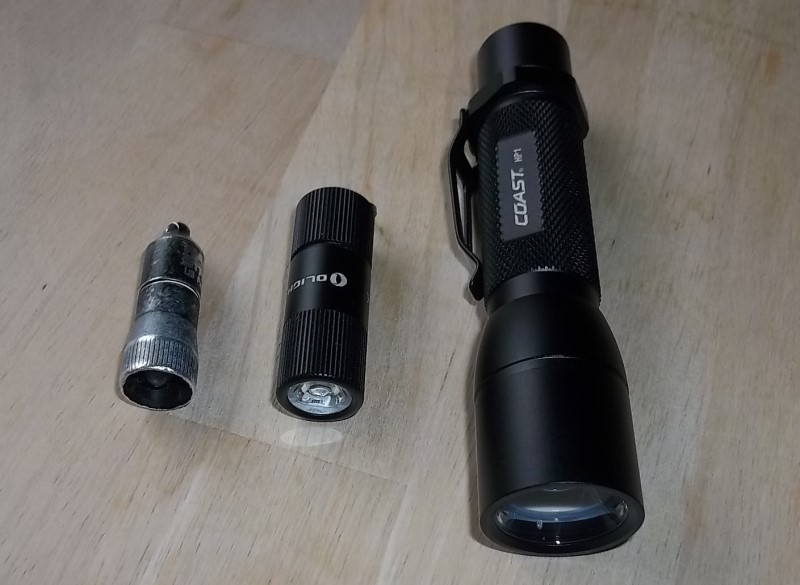
As you can see, the Olight is a bit bigger in both length and diameter than the Streamlight, but still MUCH smaller than your standard handheld flashlight. Plus, it doesn’t weight much more either, barely noticeable at 0.46 ounces compared to 0.36 ounces… and I think that’s without batteries installed in the Streamlight Nano. In any case, size and weight aren’t much of an issue for the Olight i1R 2 EOS, in my opinion, and my wife hasn’t complained yet either, which is the biggest bonus of all. 🙂
The biggest question is that of brightness and how long it lasts. As for run time time, the manual for the Olight states that it can run for roughly 15 minutes on high and up to six hours on low on a single charge. (And did I mention that it has two settings? That’s something other keychain lights don’t tend to offer, including my trusty Streamlight Nano.) Anyway, I tested this out and I found that the Olight ran for closer to 20 minutes on high without losing any obvious brightness; I didn’t bother to check the run time on low as I’ll just take their word for it. Here’s a comparison of the Streamlight (on the left) vs. Olight (on the right) with the Olight on low brightness illuminating a bathroom backspash:
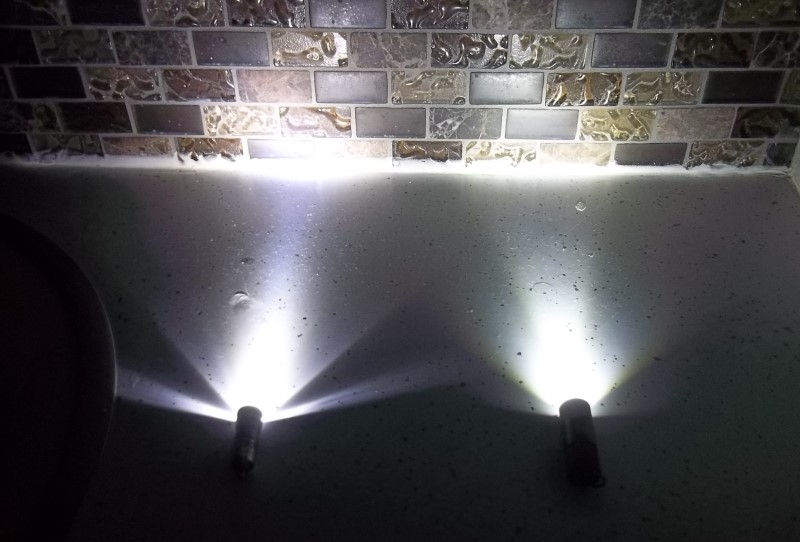
As you can see, they’re relatively close in output which, in my opinion, was plenty good as I always had enough light to see what I needed to with the Streamlight. Given that the Olight can last for several hours like this, that’s great! Running the Olight on high is a different story. I actually moved the flashlights back a bit so you can get a better idea of their difference in brightness:
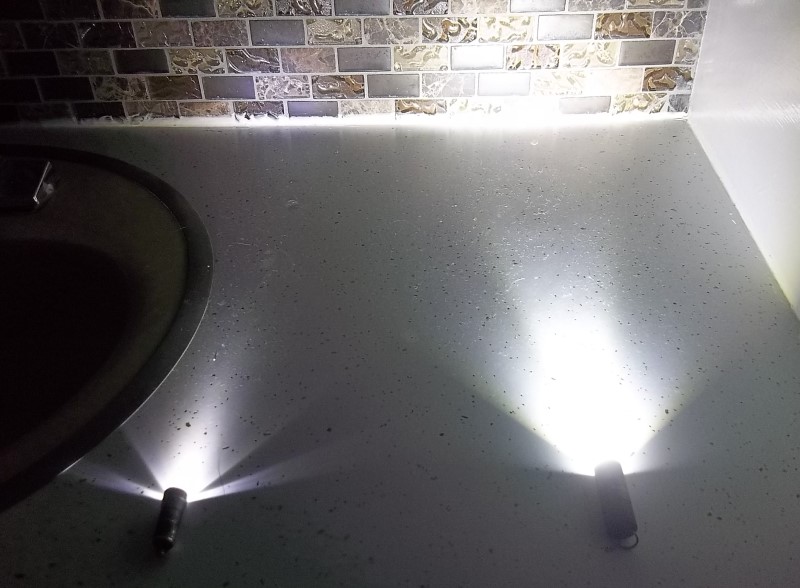
Clearly, the Olight (on the right) puts out a lot more light than the Streamlight (on the left) and, in fact, the above photo doesn’t do the difference enough justice. Remember, of course, that the Olight sacrifices battery power to do so. Fortunately, the Olight defaults to the low setting when you first twist it ON; you must then continue to twist the flashlight more clockwise to get to the higher brightness, which is what I prefer.
[On a side note: I prefer twist ON/OFF keychain lights as opposed to push button lights because I feel they’re less likely to be accidentally switched on when in your pocket or purse. This isn’t to say they can’t be turned on, they can, just less likely.]
Out of curiosity, I decided to swap out the Streamlight Nano and replace it with the recently-bought Coast HP1 handheld flashlight (shown on the left below) and I found that the brightness was quite comparable with the Olight on high:
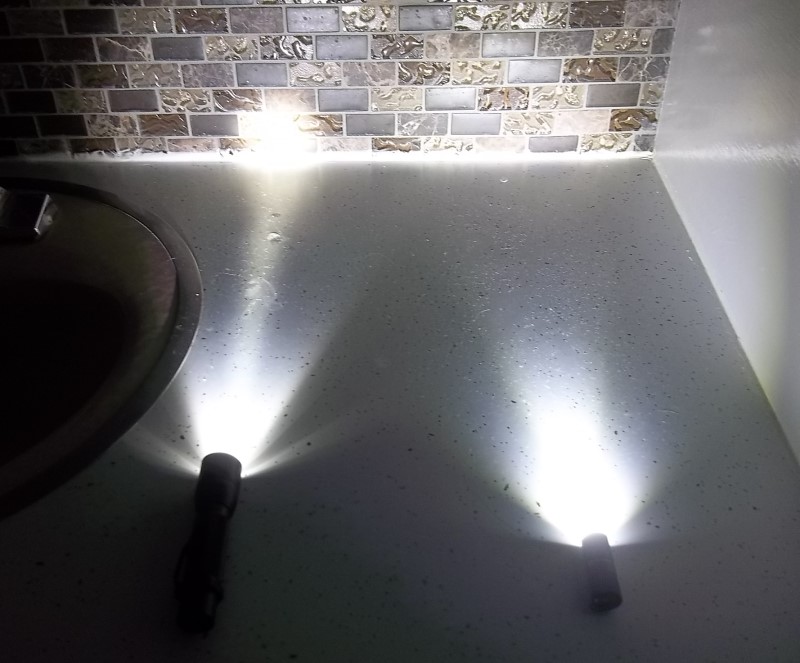
Of course, the HP1 will last a lot longer than the Olight using a single AA battery as opposed to an internal one.
Charging the Olight is rather easy, just “unscrew” the housing to expose the charging port and plug in a micro USB cord (not included) and it will charge in about an hour; there’s an indicator light–shown in the photo below–that turns green when it’s charged, red otherwise:
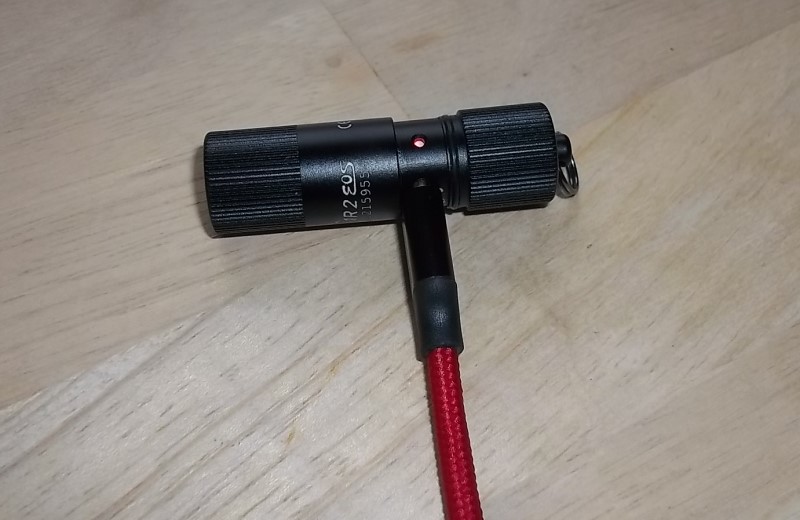 I should mention that the first time or two I tried to plug in the cord that I was pushing against the ends of the flashlight to hold the light in place while I inserted the cord which made it feel a bit flimsy. Once I started to push from the center (directly opposite the charging port) it went together much easier and felt sturdy.
I should mention that the first time or two I tried to plug in the cord that I was pushing against the ends of the flashlight to hold the light in place while I inserted the cord which made it feel a bit flimsy. Once I started to push from the center (directly opposite the charging port) it went together much easier and felt sturdy.
Let’s wrap up with a pro/con list:
Pros:
- Small and lightweight; although a bit larger than the Streamlight I’m accustomed to, it’s not at all noticeable on my keychain.
- Twist to turn ON/OFF which makes it less likely to be accidentally switched on in your pocket, though, I should point out that my Streamlight–which also twists on/off–began to twist very easily and would accidentally turn on as a result! I ended up using plumber’s tape to give the threads something to hold fast to which has worked well for years.
- Two brightness settings with “low” being the default/initial setting.
- Long run time on low (up to six hours) which, when used judiciously, should be plenty for any short-term emergency use.
- Rechargeable internal battery which means I don’t have to spend money on replacing watch batteries though, to be honest, I didn’t have to do so very often, maybe once every year or two.
Cons:
- Costs about twice as much as the Streamlight, but given that I expect to save money by not buying batteries, it’s an investment.
- Twists open to expose the USB charging port; I’m a little leery that this mechanism will fail on me eventually as I would’ve much preferred that the charging port were simply exposed on the outside of the casing, but only time will tell whether I’m right.
- No charging cable included; I was a bit surprised that they expected me to already have a micro USB cable, but it wasn’t a big deal because I happen to have a few extras… along with every other charging cable known to man, lol.
Ultimately, the Olight i1R 2 EOS does appear to be a better keychain flashlight than even my trusty Streamlight Nano, and if you’re looking to get a deal, yet still have a solid keychain flashlight, the Streamlight Nano (pack of two) is a still a good choice… but if you want a better keychain flashlight, go with the Olight.
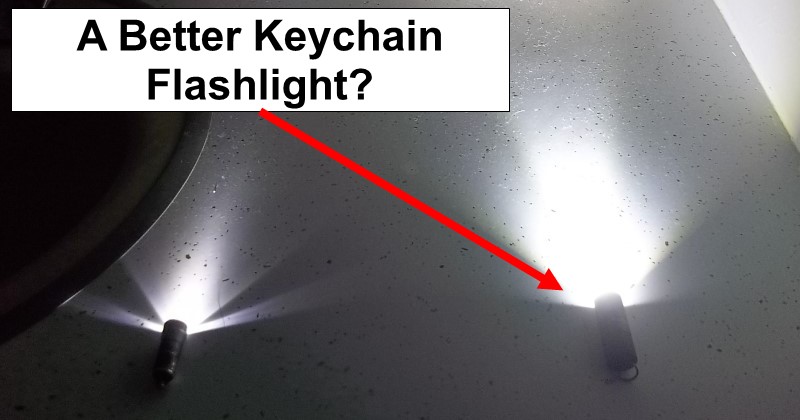
Leave a Reply to Damian Brindle Cancel reply